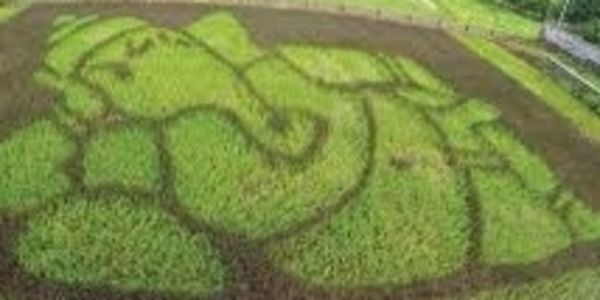
Paddy Art in India
One might have come across huge paintings, especially murals, huge rangoli designs or large flower patterns, but have you ever heard of a paddy field being used as a painting surface? Well, this unique art form started by the farmers of Inakadate village in Japan in 1993 has been introduced to India by an amateur Botanist – Mr. Shrikant Ingalhalikar. This art form which is called “Tambo Ata” by the Japanese involves the creation of huge pictures on paddy fields with the help of crops. Shrikant, after being inspired by this art form has created a picture of Lord Ganesha at a farmland in Donje Phata, Pune. The beautiful image of Lord Ganesha comprises of two colours and is 40 metres in length. Shrikant, an engineer, botanist and agriculturist chanced upon this art form while working on the conservation of rice varieties. In the course of his work, he happened to visit a site on the internet which brought to light this art which the Japanese farmers created 24 years ago. It is believed that the Japanese created this art form to celebrate the 2000-year-old rice cultivating tradition. They wanted to do something different and invented this innovative style of growing rice. It will be interesting to know that some varieties of rice yield coloured leaves. The Japaneses decided to grow these different types of rice crops to create a huge picture on the field. Their first picture was of Mount Iwaki, a stratovolcano in Japan. The strategically placed rice crops gradually grew into a beautiful large scale artwork which instantly grew popular among the locals so much that it became an annual festival in Inakadate. Now, with the help of computer graphics, they are able to make large portraits on paddy fields. Shrikant delved deep into this interesting art. He found that there is a type of rice crop in India which has black coloured leaf. He thought it would be apt to use both the green and black varieties for his creation. The initial step involves drawing the design on paper and then on the computer. The picture to be drawn is divided into squares and the size depends on the ratio of the picture and the field used. After thorough preparation, he started to plant the crops with his farm laborers in the first week of August on half an acre of his farm. To view the results of all the efforts requires tremendous patience, but once the crops grow, the beautiful painting is formed on the paddy field. It definitely becomes a very rewarding experience.
